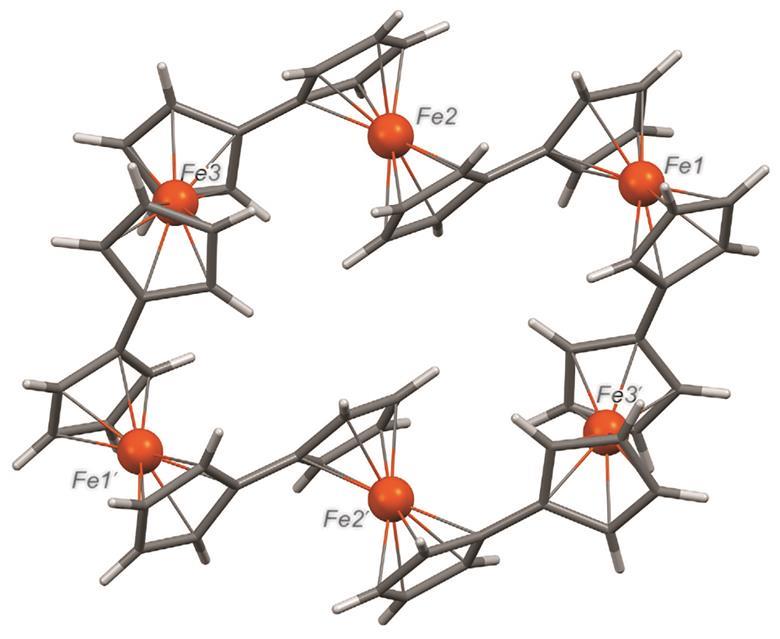Research
Synthetic Inorganic and Organometallic Chemistry for Functional Molecules
In the last fifteen years, I have developed a diverse, multi-faceted research programme of both academic and industrial relevance featuring innovative applied synthetic chemistry (crossing traditional inorganic and organic boundaries). We are carrying out world-leading research in ligand and compound design, executing fundamental science combined with considerable impact and relevance. I am particularly enthusiastic about the application of the new molecules that my group synthesises and the development of new, interdisciplinary research lines. Our strengths lie in synthetic inorganic/organometallic chemistry and elegant synthetic strategies have been developed, dovetailed with utilisation of the new compounds for applications within catalysis, materials science and biomedical imaging.
Biomedical Imaging Agents and Technologies
This works involves rational probe design, via small molecules or functionalised nanoparticles, to effect new and improved biomedical (PET, MRI, optical, ultrasound) imaging agents that has significant impact on the early detection of disease and the evaluation of medical treatment.
Biomedical Imaging Agents and Technologies
Functionalised Iron Oxide Nanoparticles and Functionalised Microbubbles for Cancer Imaging
In collaboration with Prof. Eric Aboagye (Surgery and Cancer), we are developing novel MRI contrast agents for cancer imaging, comprising superparamagnetic iron oxide nanoparticles (SPIOs) conjugated to peptide ligands of CXCR4, which is overexpressed in tumours. We have devised a novel and patented process whereby the nanoparticles ‘self-assemble’ in the body to increase the normally poor sensitivity, as well as being targeted to the required areas i.e. tumours. This work demonstrates the potential of CXCR4 targeting together with MMP trigger and copper-free click chemistry for efficient and more sensitive cancer MRI in vivo. This work will help to pave the way towards the development of further ‘smart’ targeted nanoparticles and nanomedicines for a variety of diseases. We have recently developed 68Ga-labelled microbubbles for dual-modal PET/US imaging.
Key references: Chem. Sci., 2019, 10, 5603; Angew. Chem. Int. Ed., 2018, 57, 5808; Nanoscale, 2017, 9, 11318; Angew. Chem. Int. Ed., 2014, 53, 9550; J. Mater. Chem., B, 2014, 2, 868; Dalton Trans., 2014, 43, 5535; Chem. Soc. Rev., 2013, 42, 7816; Am. J. Nucl. Med. Mol. Imagaing, 2013, 3, 372

Dual-Modal MRI/Optical Imaging Probes
In recent years there have been increasing reports of multimodal imaging probes whereby two or more imaging modalities are combined. The combination of modalities leads to probes which give enhanced visualization and improved reliability of data by synergistically combining imaging techniques to overcome their inherent disadvantages. MRI gives high anatomical resolution and deep tissue penetration, but lacks sensitivity. Optical imaging however, boasts high sensitivity but has limited tissue penetration. The combination of the two techniques yields a probe which is able to provide a more complete picture of the biological area of interest. There are few reports of dual-modal MRI/optical imaging agents in the literature that are not of nanoparticle nature, and we have recently reported two novel methods for conjugating fluorescent rhodamine derivatives to DO3A, a small aza-macrocycle. We evaluate the two rhodamine-DO3A Gd(III) derivatives as multi-modal MRI/optical imaging agents by measuring their relaxivity and fluorescence properties, as well as their in vitro tumour cellular localization. The Tb(III) analogues were synthesized to assess their dual-luminescence properties, showing that the organic and the metal-based luminescence can be separated on different timescales.
Key references: Nat. Commun., 2019, 10, 1420; Nanotheraostics, 2017, 1, 186; Inorg. Chem., 2013, 52, 14284
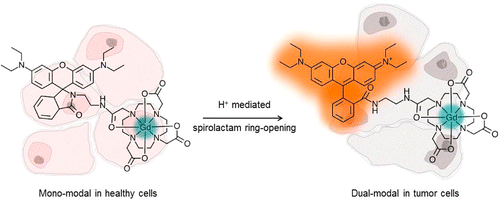
Development of Chemical Methodologies for 11CO PET Radiolabelling
Processing and reacting short-lived radioactive gases is an extremely challenging area of synthetic chemistry. This problem is further exacerbated when those gases are poorly reactive. Our approach to this 11CO reactivity problem was to devise a chemical trapping method to enhance 11CO reactions and avoid the need for complex and specialised equipment. Our trapping and reaction method is based on using inorganic complexes that contain transition metals that are uniquely capable of sequentially trapping, concentrating and then releasing 11CO from a gas stream. It is anticipated that the technical simplicity of this method coupled with its efficiency will make 11CO chemistry more readily accessible to non-specialists. In collaboration with Prof. Tony Gee (King’s College, London), we are now using the technique to form a range of 11C labelled biomolecules for PET imaging ready for the clinic.
Key references: Chem. Commun., 2017, 53, 2133; Eur. J. Inorg. Chem., 2014, 1896; Dalton Trans., 2012, 41, 83; Chem. Eur. J., 2011, 17, 460; Org. Biomol. Chem., 2011, 9, 3313; J. Label. Radiopharm., 2011, 54, 135; Adv. Synth. Catal., 2009, 351, 3260; Chem. Commun., 2009, 3696
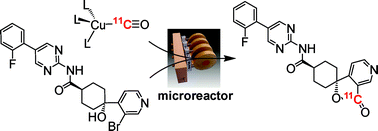
Dual-Modal and -Functional Metal Chelates for Biomedical Imaging: Zinc-Sensing for Diabetes Diagnosis
In this work, via collaboration with Prof. Guy Rutter (Medicine), we have formed a series of dual-modal MR/NIR fluorescent zinc sensing probes for diabetes imaging, in order to advance the area of molecular imaging. Despite the contribution of changes in pancreatic beta cell mass to the development of all forms of diabetes mellitus, few robust approaches currently exist to monitor these changes prospectively in vivo, restricting our understanding of disease aetiology and opportunities for personalized treatment. Whilst magnetic resonance imaging (MRI) provides a potentially useful technique, targeting MR-active probes to the beta-cell has proved challenging. Zinc ions are highly concentrated in the secretory granule, but relatively less abundant in the exocrine pancreas and in other tissues. We are therefore developing functional dual-modal probes based on transition metal chelates capable of binding zinc.
Key references: Chem. Commun., 2018, 54, 3227; Dalton Trans., 2015, 44, 4476; Chem. Eur. J., 2015, 21, 5023

PET- and MRI-Labelled Formyl Peptide Receptors for Imaging of Inflammation
The host inflammatory response requires tight regulation and control, to avoid overshooting, prolongation and self-induced damage, which are associated with a number of brain diseases, and other diseases such as cancer, myocardial infarction, vasculitis and diabetes. Monocytes are circulating blood leukocytes that play important roles in the inflammatory response and the pathogenesis of inflammatory diseases. Neutrophils are among the first leukocytes to reach a site of injury, and they are abundant at focal sites of infection. The ability to detect and quantify monocytic accumulation will enable scientists not only to locate and identify inflammatory lesions but will also facilitate the development and testing of anti-inflammatory agents for drug discovery. In collaboration with Dr. Felicity Gavins (Louisiana State University) we are developing novel imaging probes that are able to specifically bind to monocytes to detect both acute and chronic inflammation using PET, MRI and optical imaging. This result in an improved diagnostic marker for the clinic and a tool to assess the efficacy of novel anti-inflammatory therapeutic drug targets for the treatment of brain related diseases. We are now deliverig probes to the brain via a focused ultrasound technique in colloboration with Dr James Choi (Bioengineering).
Key references: Radiology, 2019, 291, 458; Dalton Trans., 2015, 44, 4476; Chem. Commun., 2013, 49, 564

Imaging Cell Death via 18F and 68Ga PET Radiolabelling
Mitochondrial dysfunction is firmly linked to a number of disease states including those of cardiometabolic, oncologic and neurodegenerative origin such as cardiovascular disease, cancer, Parkinson’s disease and dementia. Although seemingly unrelated, these conditions share common factors, such as the production of reactive oxygen species, genetic variants, aging and a reduction in mitochondrial biogenesis, which all contribute to mitochondrial dysfunction and the development of disease pathology. Positron Emission Tomography (PET) is a non-invasive imaging approach that allows the visualisation and quantification of biological processes at a molecular level. Lipophilic cations, which accumulate in mitochondria due to the electrochemical membrane potential, provide a potential target for novel PET probe development. Indeed, recent developments support the application of labelled lipophilic cations as imaging probes of apoptosis in oncology. In collaboration with Imanova Ltd., we have developed novel fluorine-18 labelled lipophilic cations, that have demonstrated encouraging results in vitro as imaging agents that sense changes in mitochondrial membrane potential in various bodily organs.
Key references: J. Nucl. Med., 2019; Dalton Trans., 2018, 47, 15448 ; Mol. Pharm., 2014, 11, 3818 ; J. Label. Radiopharm., 2013, 56, 313
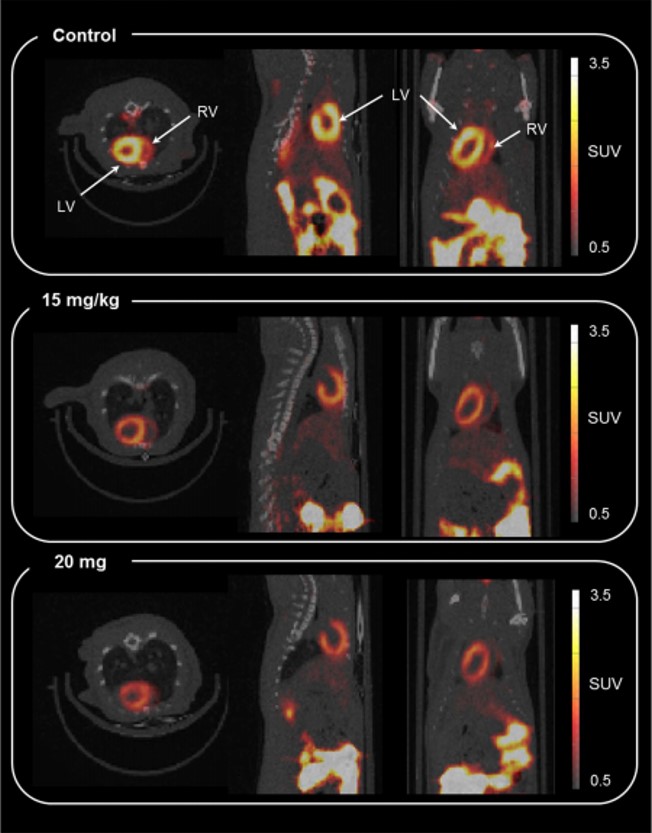
New Ligands and Complexes for Homogeneous Catalysis
The design of novel ligand and metal catalysts has enormous ramification for chemical syntheses and industrial processes. Our work has impact in the understanding of metal-ligand reactivity and the control of industrially-relevant processes such as olefin and lactide polymerisation.
New Ligands and Complexes for Homogeneous Catalysis
Isotacticity and Rate Control in Lactide Polymerisation
Via collaboration with Prof. Charlotte Williams, we have developed a new class of ancillary ligand: an iminophosphorane derivative of the popular “salen” ligand, termed “phosphasalen”. This versatile ligand framework allows for much functionalization and derivation, and lends itself to the development of families of metal pro-catalysts from which meaningful trends and data can be elucidated. Within lactide polymerisation, one of the greatest challenges is to engineer some polymer tacticity control via the metal catalyst. We have demonstrated that yttrium phosphasalen initiators are highly active for the stereocontrolled ring-opening polymerization, and they enable access to high iso-selectivities (Pi = 0.84) or hetero-selectivities (Ps = 0.87). The initiators also show very high rates, excellent polymerization control, and tolerance to low loadings; furthermore, no chiral auxiliaries/ligands are needed for the stereocontrol. The combination of such high rates with high iso-selectivities is very unusual.
Key references: Organometallics, 2012, 31, 4729; J. Am. Chem. Soc., 2012, 134, 20577; Inorg. Chem., 2013, 52, 12561; Organometallics, 2013, 32, 1475; Angew. Chem. Int. Ed., 2014, 53, 9226; Dalton Trans., 2015, 44, 12326
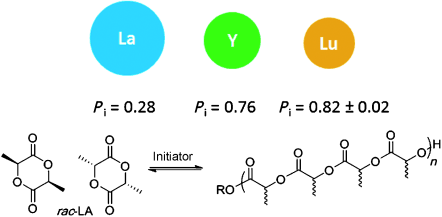
Redox-Active Catalysis
In a proof of concept study, we have established for the first time that redox switches may be used to attenuate the activity of single-site polymerization catalysts. Thus, a titanium-based lactide polymerization initiator supported by a ferrocenyl-substituted salen ligand exhibits a substantially higher rate of propagation than its oxidized dicationic ferrocenium analogue. The reversibility of the redox event is demonstrated by treatment with chemical redox reagents.
Key references: J. Am. Chem. Soc., 2006, 128, 7410; New J. Chem., 2011, 35, 2162; Chem. Commun., 2013, 49, 5663; Dalton Trans., 2013, 42, 2813; Dalton Trans., 2019, 48, 72
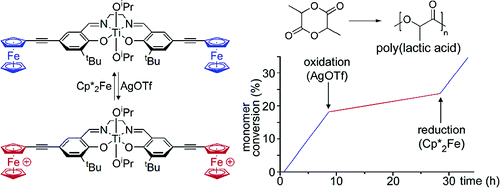
Robust Multidentate Ligands and Transition Metal Complexes for Biomass Conversion and Dinitrogen Activation
N-centred triphosphine ligands constitute a class of robust ligand that are virtually unexplored for both coordination chemistry and catalytic applications. With Dr. Phil Miller and Dr. Andrew Ashley, we are designing a range of multidentate phosphine ligands to bind to metals such as Ru, Rh, Mo to form stable but functional catalysts for high temperature processes such as biomass conversion, carbonylations, hydroformylations, dinitrogen activation etc.
Key references: Chem. Commun., 2019. 55, 6579; Dalton Trans., 2018. 47, 11386; Dalton Trans., 2016. 45, 5536; Coordin. Chem. Rev., 2015, 299, 39 ; ACS Catal., 2015, 54, 2204 ; Inorg. Chem., 2014, 53, 3742
Electronic materials
Electronic Materials
Metal-Metal Communcation and 'Ring-tronics'
This work explores the synthesis, electronic and spintronic properties of linear-, in phase- and ring-shaped molecules with multiple transition metal centres. This new class of materials is expected to display quantum interference and spin frustration effects, which will provide fundamentally new insight into the properties of such complex molecular structures. Ultimately, these properties could be exploited in novel types of single-molecule quantum-electronic devices. With collaborator Dr. Tim Albrecht, projects are interdisciplinary, involving chemical synthesis and single-molecule characterization at room- and ultralow-temperatures.
Key references: Chem. Mater., 2017, 29, 8663 ;Angew. Chem. Int. Ed., 2017, 56, 6838 ; Nat. Chem., 2016, 812, 145 ; Dalton Trans., 2014, 43; Organometallics, 2013, 32, 6053; Chem. Eur. J., 2008, 14, 4346; Organometallics, 2006, 25, 2525
